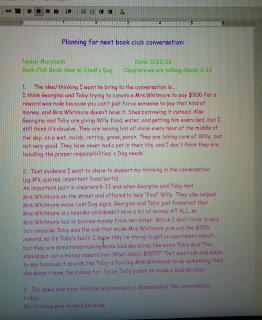
Today is the final day of March, so it is also the last day of daily slicing, a challenge hosted by Stacey and Ruth at twowritingteachers.wordpress.com.
I am so glad that I participated in the Slice of Life Challenge throughout the month of March for many personal and professional reflections. This morning, before I go hide 300 Easter eggs and make lunch for seventeen, I will try to list some of them.
- I wrote creatively. I have spent so much time over the last year with a new blog writing about the practice of teaching that I left my private writing life and I didn't realize how much I miss it until I re-visited it this month. To honor the mission of the professional blog that I share with Melanie Swider (tworeflectiveteachers.blogspot.com), I started a new blog for my stories and more personally-oriented work. I will continue to write as much as I can at justwritemelanie.blogspot.com.
- Audience matters. The connections to a world of writers propelled me. Even though I belong to a writers' group, we meet monthly at best and the instantaneous response in the world of the Slice Challenge felt great. This reflection has an impact on my ideas about teaching practices. I didn't always want to know what I can do better in a piece; I wanted to know that someone had read it and thought enough of it to say something.
- Writing begets writing. I have heard people compare writing and reading to exercise in that the more we do them, the easier they become. I never had that experience with running--it always stays hard!-- but I did have that experience with writing. Daily writing became part of my day.
- Reading other people's writing inspires writing. I found inspiration in other people's posts all the time--what they did during the day that became important through documentation, memories that they shared, important people. I wonder about this last two realizations and our practices as writing teachers. Do we have time in the workshop set up for reading and responding to each other's work? Is the typical five minutes enough? There were definitely days when I spent more time reading and commenting than on writing.
- Alan Wright's blog is called Living Life Twice because, he writes on his blog, "People who write get to live life twice - in the moment and in retrospect. That's what sets writers apart. I rarely go anywhere, or do anything without the shadow of my writing self being part of the adventure. Every experience provides opportunities to harvest writing ideas. It is a lens through which to view the limitless possibilities of the moment." I have thought of his words many times throughout this month because I really have noticed life differently, given the pressure of a daily slice. In the classroom, I wonder about teaching more of the noticing that goes along with writing. I could not just sit down at the computer and concoct my post; I noticed and nurtured a thought, memory, reflection, or moment before the actual writing. My writing life encompassed much more than the hour or so that I wrote, read and commented. What does this mean for our teaching practices?
I have learned more, but I know that there will be many reflective words to read today as we all finish our month of daily writing. Thank you to Ruth and Stacey for creating this experience, thank you to all of the people who have helped, and thank you to all of the people who have read and commented on my work throughout the month. I will miss the routine but will certainly continue on a weekly basis and I look forward to next March.
Have a wonderful day,



























.png)










